AVADirect Clevo P170EM Part 2: GTX 680M Grudge Match
by Jarred Walton on October 15, 2012 6:50 PM ESTClevo P170EM Battery Life Revisited
I noted in the first P170EM review that battery life was rather poor, even for a high-end notebook. I felt at the time that the BIOS/firmware was to blame, but without an official download location from Clevo I was hesitant to update either notebook. I still feel Clevo is really making a mistake by not providing official BIOS updates—they would rather you contact your notebook vendor and ask for a BIOS—but I decided to go ahead and snag the latest BIOS for the P170EM from the Notebook Review forums’ Clevo BIOS thread. (That you’re able to get better BIOS support via NBR forums than from Clevo is beyond ludicrous.)
Updating the EC/KBC firmware to version 1.00.09 and the BIOS to version 1.00.10 wasn’t quite as simple and painless as I’d like. Specifically, the EC updates (I tried all of them before taking the next step) are for ROM ID P170EMx whereas the AVADirect notebooks both have ROM IDs of P170EM (no “x” suffix), so I had to use the “ignore ROM ID” option. I don’t if that’s something related to the notebook vendor or just par for the course, but by default I couldn’t just run the flash utilities. The BIOS on the other hand updated without any issues. When all was said and done, I then retested battery life, and sure enough things have improved quite a bit—though oddly, where the GTX 680M and HD 7970M were quite close before, the GTX 680M now does quite a bit better. Both dGPUs should be off during our battery life testing, so I’m not sure what’s going on here; perhaps the BIOS/firmware still isn’t fully optimized for the AMD GPU.
We’re including the before/after results for both the HD 7970M and GTX 680M after applying the BIOS/firmware updates. The original BIOS was 1.00.05 while the updated BIOS is 1.00.10.
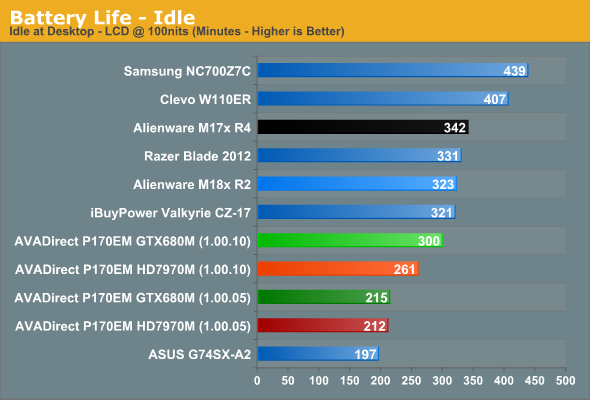
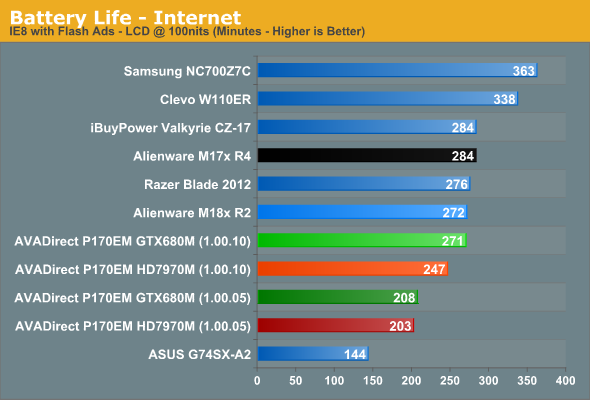
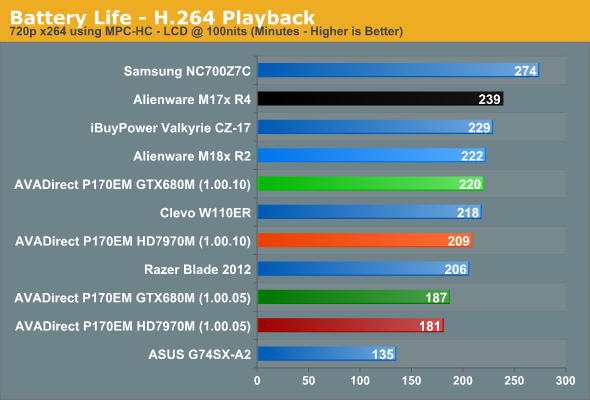
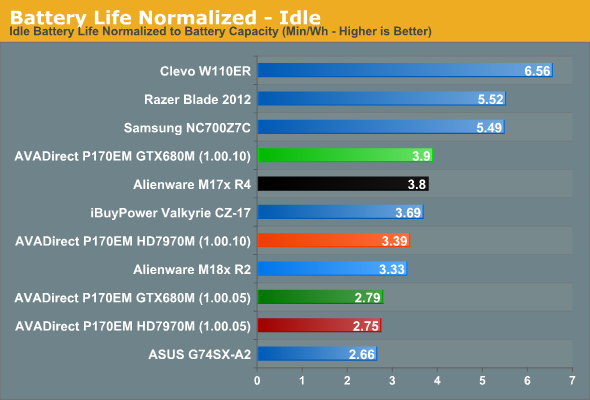
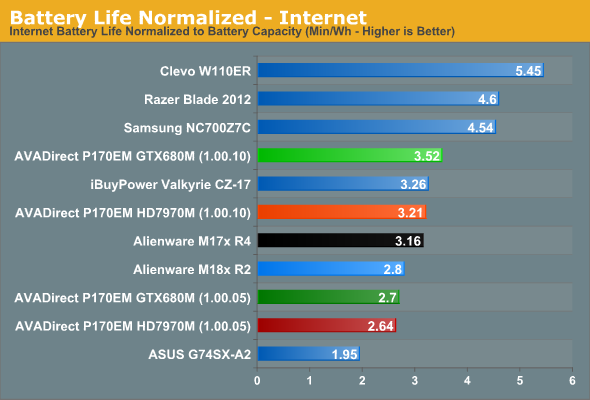
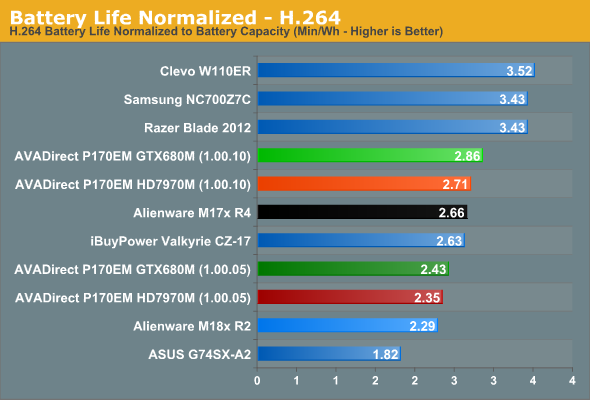
Oh what a difference a BIOS makes. We’re still nowhere near matching the prowess of designs like the Samsung Series 7 or Razer Blade, but we’re dealing with a substantially larger chassis that has the ability to support three spindles plus an mSATA drive—not to mention FireWire and several other seldom-seen features. I still feel like both the Alienware M17x and the P170EM could do better with further optimizations, but at least with the updated BIOS/firmware Clevo is able to surpass the normalized battery life of Alienware in most cases.
While the battery life improves on both laptops with the updated BIOS, it’s perplexing that the HD 7970M version is using substantially more power—idle power draw is ~15.1W for the GTX 680M compared to ~17.3W for the HD 7970M. We’re not using the same physical notebook of course (so there’s a different LCD, motherboard, battery, etc.), but even so that particular result is more than a minor deviation. Power draw during our Internet test is ~16.7W for the 680M vs. ~18.3W for the 7970M, so it’s a bit closer, and for H.264 playback the 7970M draws ~21.7W vs. ~20.6W for the 680M. Basically, the higher the loads on the system as a whole, the closer the two notebooks are in battery life and power use.
But despite the above concerns regarding AMD vs. NVIDIA, the fact is the P170EM is a large gaming notebook and battery life is only a secondary (or tertiary) concern. It’s good to see close that we’re able to hit around 4.5 hours of moderate use on battery power, and that should be enough for most people. Sure, if you fire up a game (or happen to come unplugged), your battery isn’t going to last that long, but if you’re trying to bulk up by carrying around a 10+ pound notebook + accessories at school you could conceivably get through four hour long classes before you need to plug in. I should also note that charging times are quite reasonable for the battery, taking under two hours to reach 100% even when you’re putting a significant load on the system; that’s where having a large enough power adapter is beneficial: under full load, the P170EM still doesn’t come near the 220W rating of the power brick.










58 Comments
View All Comments
JarredWalton - Tuesday, October 16, 2012 - link
It should be possible, but buying a GTX 680M module on its own can cost $900 or something insane. If anyone has a good link to where you can find just a GPU upgrade for the P170EM, please post. Best I can find right now is on eBay:http://www.ebay.com/itm/CLEVO-X7200-UPGRADE-KIT-NV...
Needless to say, waiting for the Hotfix at this point is reasonable. Barring that, I'd suggest selling your existing system and buying one with GTX 680M rather than just paying for the GPU upgrade.
Wixman666 - Tuesday, October 16, 2012 - link
Don't worry about it.. the difference isn't large enough to upgrade the video or take a bath on selling then buying the other unit.TrantaLocked - Tuesday, October 16, 2012 - link
Great review Jarred!Jamahl - Tuesday, October 16, 2012 - link
Fact is this is a very Nvidia-friendly gaming suite - that's why this site consistently scores as an outlier for Nvidia. As a rule of thumb you want to subtract 10% from the overall result to find the true position of the Nvidia card - true as in what the majority of the tech press find.Even then this particular review is pretty horrible on the 7970, as it has had the best performing games removed (Crysis and Metro). Quite why those are worth removing instead of the complete Nvidia outlier Portal 2 is a mystery (I'm sure we all have our suspicions), but there you go.
JarredWalton - Tuesday, October 16, 2012 - link
You include Crysis and Metro and then suggest our gaming suite needs updating? Give me a break. We removed Crysis as a test game for laptops about two years ago... when Warhead was "only" two years old already. When we revise the gaming suite next time, I'm pretty sure we'll drop Civ5, TWS2, and some of the other games. DiRT 3 was originally an AMD game, but NVIDIA has long since caught up. Civ5 was also an AMD game. Total War: Shogun 2 is an AMD title as well. You see the problem with your assertion that we're "NVIDIA-friendly" yet? So here's the full rundown of the fifteen tested games:Batman: NVIDIA
Battlefield 3: NVIDIA
Borderlands 2: NVIDIA
Civilization V: AMD
Diablo 3: Agnostic
DiRT 3: AMD
DiRT Showdown: AMD
Elder Scrolls Skyrim: Agnostic
Guild Wars 2: Agnostic
Max Payne 3: NVIDIA
Portal 2: Agnostic
Sleeping Dogs: AMD
Sniper Elite V2: AMD
Total War Shogun 2: AMD
Witcher 2: NVIDIA
Final tally:
AMD Titles: Six
NVIDIA Titles: Five
Neutral Titles: Four
The problem you're having is that NVIDIA has generally spent more time and effort optimizing for games, which means that some of the neutral and AMD-sponsored games are now running better on NVIDIA hardware than on AMD. Or maybe you think it's unfair that when we sort alphabetically, NVIDIA titles happen to occupy the first three slots and AMD has three of the last four? Going back to run games that few people are still playing just to try to make things "fair" is actually being the exact opposite. Crysis and Metro? Please. Why not Crysis 2 at least -- oh wait, it's an NVIDIA title.
Brainling - Tuesday, October 16, 2012 - link
Crysis and Metro? Seriously? It's almost 2013, we're four full game cycles away from the release of Metro, and much farther from Crysis.For that matter, my 670 barely breaks a sweat on Metro at 1200p max everything , why would you test a 680 with it? Is it a yawning test to see how bored the graphics card can seem?
silverblue - Friday, October 19, 2012 - link
I don't think it's NVIDIA's fault as a whole that they offer better support than AMD. It's also worth showing games like Portal 2 and DiRT Showdown which have very high framerates because it's interesting to find out why one architecture might monster through them (6xx series) where another might not (7xxx series).I've never actually played Crysis, but from the benchmarks, it looks amazingly inefficient and not a complete representation of what a graphics card can and cannot do.
I used to defend AMD's drivers quite vehemently; after all, they'd never caused me any issues. However, when I see issues with Enduro, poor and non-existent Hybrid Crossfire scaling, GPU underutilisation, slack support for driver command lists, poor video encoding quality... need I go on? AMD could make the best hardware around (and, in reality, it probably does), but what would really benefit them is shifting resources to the software development side. If they're going to be powering two of the next consoles, it's in their best interests to get software support up to scratch. Hardware is all well and good but if the software support isn't completely there...
BiggieShady - Tuesday, October 16, 2012 - link
On the last page, instead of "I’ve beat that horse enough" there should be "I’ve beaten that horse enough". To Beat is an irregular verb - beat, beat, beaten. You should use past participle here - beaten. Or just stop beating the poor horse :)Tijgert - Tuesday, October 16, 2012 - link
For starters the GPU IS upgradeable (see eBay) and over time, with the release of newer GPU's, it will make financial sense to do so. Right now if you can get a great deal on a system with a 7970m you still get the second best performing card in the world with a future upgradeability guarantee (MXM is a standard, not proprietary tech).I think the reasoning of a relative graphics performance increase equal to the total price increase being reasonable or financial sound is something only a teenager or rich madman would swallow.
Given that all the other bits don't increase equally you end up paying a lot for a little.
The screen resolution stays the same, the battery lasts just as long, the CPU doesn't tick any faster, the amount of memory doesn't increase and the Gigs on your SSD don't increase either.
As long as you can get great visuals (even if not at 4xAA and enough detail to see textured zits) at a very playable framerate, you're doing just fine. Just enjoy it and wait for that 690m or 700m or whatever MXM 3.0b card to come out that's better and just upgrade.
FYI I'm on the fence on getting a completely tricked out 2200 euro (yes, euro) system that's three months old for 1560 with a 7970m... or saving for a 680m... see, I'm actually a graphics whore too even if may sound sensible at times...
JarredWalton - Wednesday, October 17, 2012 - link
If a notebook supports the newer GPU with its BIOS/firmware, you can upgrade to a newer GPU. However, just because MXM is a standard doesn't mean all MXM GPUs will work. Take for example the last-generation Clevo notebooks; I'm pretty sure the P150/170HM received the necessary BIOS update to work with 7970M/680M. However, the generation before that AFAIK can't run 7970M/680M. The cards will fit but they don't work properly. As I note below, you can't buy a P1x0EM without a GPU, though, so there's not a real need to compare pricing of just the GPUs. I'm reviewing the P170EM and looking at 7970M vs. 680M, not talking about "should you try to upgrade your older notebook with a 7970M or a 680M?"For your 7970M setup, wait for a week and then maybe we'll know if you should trust AMD's updated drivers.